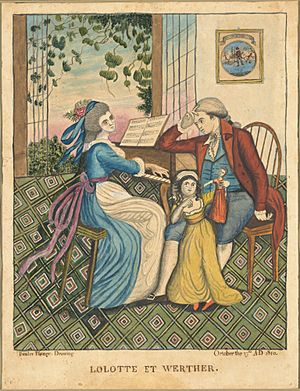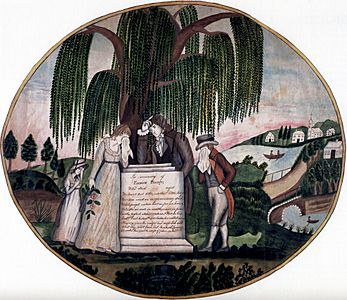Eunice Pinney facts for kids
Eunice Griswold Holcombe Pinney (born February 9, 1770 – died 1849) was an American folk artist. She lived and painted in the towns of Windsor and Simsbury, Connecticut. Experts in American folk art, like Jean Lipman, believe Pinney was one of the first American painters to use watercolors. Another early watercolor artist was Mary Ann Willson.
About Eunice Pinney
Eunice Pinney came from an important family in Connecticut and was well-educated. Her family had been in America since 1639, when Matthew Griswold moved from Kenilworth, England to Windsor, Connecticut. Her parents, Eunice Viets and Elisha Griswold, were from Simsbury. Their marriage brought together two of the most respected families in town.
Eunice was the fifth of eight children who lived to adulthood. Her older brother, Alexander Viets Griswold, became an important church leader. He was the first and only Episcopal bishop for the Eastern States Diocese. A book about his life, published in 1844, shares important details about Eunice and her family. The book says that Eunice "read a lot" and was very helpful in setting up and keeping her local church active.
Eunice married Oliver Holcombe around 1790. He was from Granby. Oliver died young, in his twenties, while traveling. Eunice had two children from this marriage: Hector and Sophia.
In 1797, Eunice married Butler Pinney. They first lived in Windsor but moved to Simsbury, where Eunice was born, around 1844. Eunice and Butler had three children: Norman, Viets Griswold, and Minerva Emeline. Minerva also became an artist. She taught painting at a school in Virginia for several years before she got married. Eunice Pinney passed away in Simsbury when she was 79 years old.
Her Art Career
Eunice Pinney's paintings that have her signature and a date are from 1809 to 1826. This makes experts think she started painting later in her life, after her second marriage. Most of her work was done in Windsor and Simsbury. Like other artists of her time, she probably taught herself how to paint.
Pinney's watercolor paintings that we still have today show many different things. She painted everyday scenes, landscapes, and portraits of people. She also created allegories (pictures that represent ideas), historical and religious stories, and memorial scenes. Her paintings are known for being well-balanced and having strong figures, clear outlines, and bright colors.
-
This memorial painting was made by Eunice Pinney in 1813. It is a watercolor on paper and is now at the Museum of Fine Arts, Boston.
Even though she painted in the 1800s, the people in her art often wear clothes from the 1700s. One art historian, Jean Lipman, said that Pinney's painting style and even the clothing in her pictures look like they belong to the 1700s. It's almost like she was a person from the 1700s who painted in the early 1800s.
Many of her paintings, especially those with historical or story themes, might have been inspired by popular English pictures. For example, her painting Couple and a Casualty (around 1815) seems to be based on an English design printed on fabric. Pinney might have also found ideas from rare English fabric patterns. However, her everyday scenes and memorial paintings are completely her own ideas. They show a clever use of color, strong figures, and detailed designs. Art experts have compared her work to that of Thomas Rowlandson because it feels so lively and dramatic.
We don't know if Pinney directly taught her daughter Minerva how to paint with watercolors. But Eunice did send paintings to Minerva when she was teaching in Virginia. These paintings were used as examples for Minerva's students.
Where to See Her Art
Many of Eunice Pinney's paintings are still owned by her family today. However, some important examples can be seen in public art collections. These include the National Gallery of Art in Washington, D.C., and the American Folk Art Museum in New York City.
See also
 In Spanish: Eunice Pinney para niños
In Spanish: Eunice Pinney para niños



